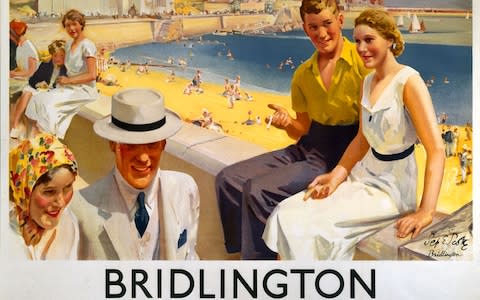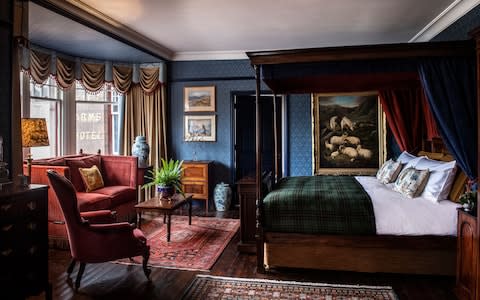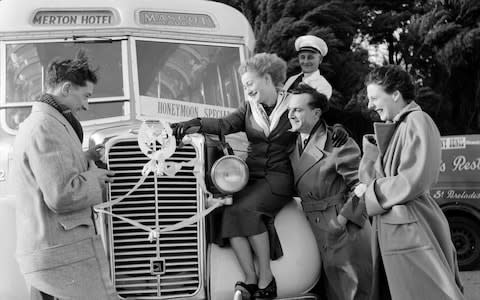From camping in the country to island escapes: How honeymoons have changed in the last 100 years

1920s
The concept of a honeymoon really took off in the 19th century, when it was known as a “Bridal Tour”. Pity the poor newly-weds who had to embark on lengthy trips with their families in tow to visit yet more family members scattered around the country (or, shudder, continent).
Thankfully, by the early 20th century, the parents had been shaken off and it was all about couples spending quality time together. It became a significant rite of passage. Bright young things could be found in London’s grandes dames – Claridge’s being a coveted post-wedding spot.

• The world's 50 greatest honeymoon hotels and destinations
The same was true across the pond: icons of the Jazz Age, F Scott and Zelda Fitzgerald, decamped to a suite at the now defunct Biltmore Hotel in Midtown New York shortly after their 1920 wedding. Chaos duly ensured, with accounts of cartwheeling in the lobby and ordering champagne and – inexplicably – fresh spinach for midnight snacks. They eventually moved to the nearby Commodore (now the Grand Hyatt) where, upon arrival, they supposedly spun in the revolving doors for half an hour.
1930s
For the average couple, a honeymoon in the interwar period often meant a trip to the great British seaside – towns such as Scarborough and Bridlington in the north, and Worthing and Newquay in the south. During the Thirties, many coastal resorts maximised their offerings by installing sparkly new lidos. The Jubilee Pool in Penzance opened in the middle of the decade with its modern triangular design and location right on the shoreline. The pool reopened in 2016 after a £3m restoration, and looks better than ever.

• Britain's most romantic hotels
1940s
After the Second World War, honeymoons were, understandably, low-key, although couples did still celebrate, on road trips or simple camping holidays. With Britain still in the grips of rationing, the Queen and the Duke of Edinburgh took a relatively understated honeymoon after their 1947 wedding, heading up to Birkhall in Scotland (part of the Balmoral estate), where Her Majesty spent many childhood summers. Present-day honeymooners can enjoy their own highland fling with a stay at the artistic Fife Arms at Braemar, around half an hour from Birkhall. Opt for a wildly romantic Croft room with wooden cabin-style bed.

1950s
Jersey proved such a popular post-wedding spot in the Fifties that it became known as “Honeymoon Island”. With most young couples having never left mainland Britain, the Channel Island seemed rather exotic, with its proximity to France. Accounts from the time describe crowds of newly-weds boarding propeller planes and holding hands across the aisle, while hotels scrambled to ensure they had enough double beds to cope, sometimes resorting to taping singles together. A big draw was the island’s huge honeymoon balls, which would attract up to 350 couples at a time.

• 50 amazing hotels for a European mini-moon
1960s–1970s
With the boom of commercial air travel, glamorous honeymoons abroad became much more accessible, with France and Italy the most sought-after destinations. Brigitte Bardot put St Tropez on the map for romance-seekers and it became even more of a hotspot after Mick and Bianca Jagger’s 1971 nuptials in the chic fishing village. The couple kicked off their honeymoon with a stay at the Hotel Byblos, where all guests are treated like rock stars, before moving onto Venice.
Classic Italian cities such as Rome (you can thank the 1960 film La Dolce Vita for reigniting a passion for the capital) and Venice lured plenty of newly-weds, but Verona was also a popular spot, due to its role as the setting for Shakespeare’s star-crossed lovers, Romeo and Juliet. A visit to the famous balcony at Casa di Giulietta was a must, even though its connections to the play are a tad flimsy.

Over in the United States, purpose-built honeymoon resorts sprouted up in the Pocono Mountains in Pennsylvania. Strictly for newly-weds, the totally kitsch Cove Haven Resort demanded a marriage certificate with every booking, and pioneered the ruby-red, heart-shaped hot tub, which became a staple at every hotel in the area. The Penn Hills Resort went even further with a wedding-bell-shaped swimming pool and round beds in every room.
1980s
Just like Duran Duran, in the Eighties many honeymooners took to the seas. The Prince of Wales and Diana, Princess of Wales, sailed around the Mediterranean, while the Duke of York and Sarah, Duchess of York, cruised the Azores – both were, of course, aided by the use of the Royal Yacht Britannia. The decade also saw a boom in the “cruise to nowhere”, where the ship became a destination in itself. Couples could expect the latest mod-cons, such as televisions in cabins and casinos on board. On land, package holidays were flourishing, with Madeira, Malta and the Canary Islands popular with newly-weds looking for a good deal.

• The best mini-moon hotels in the UK
1990s–2020s
As the end of the 20th century loomed, honeymoons became more far-flung. The Caribbean, often twinned with stops in New York or Florida, was an enduring favourite.
Then came the Maldives, which has dominated the honeymoon scene ever since, attracting A-list celebrities, oligarchs and most of the footballers in the Premier League. It was the arrival of Soneva Fushi – pioneers of the barefoot luxury ethos – in 1995 that really launched the destination and a world of over-water villas, seaplanes and private butlers soon followed.

The swish castaway vibe continued in the Seychelles, with the opening of North Island, one of the world’s most exclusive resorts, where guests arrive by helicopter and stay in one of just 11 enormous villas that look out on to pristine white sand. No surprise that it was chosen by George and Amal Clooney for their honeymoon.
For all this unfettered glamour, there has also been a shift towards something a little quieter. Right now, this is the age of the mini-moon. Whether due to the spiralling cost of weddings, or the fact that couples are increasingly time-poor, skipping off to the coast or countryside for a weekend is proving popular once again – only this time there are freestanding baths and tasting menus. It also gives the opportunity to save and plan for a bigger trip later, because the only thing better than one honeymoon, is two.

